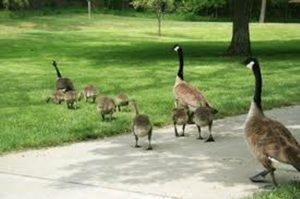How do you know if you have a GOOSE ‘ problem’
by Debra A. Marshall
Canada geese are beautiful! Their shapely, sleek, black head and neck are emphasized by the ever so infamous white jaw line marking, not to mention their majestic beauty as they fly inches from the top of the water. Who hasn’t smiled at the familiar honking as they fly in V-formation? Their splendor can leave one speechless when spotted on ponds and lakes and in parks waddling to and fro.
Yes, Canada geese ARE beautiful but when do they become a nuisance and how do you know if you have a GOOSE problem in your community?
First you need to recognize and identify the problem. While it may be favorable for residents, employees, visitors, students, and customer/clients to see nature firsthand, geese can and do threaten these types of communities and many others: neighborhoods, businesses, universities, airports, golf courses, etc. There are many possible signs that your community is being impacted by geese (or what they leave behind) which can range from: loss of the use of jogging and walking trails; unable to enjoy playgrounds, docks, party and picnic areas; unclean sidewalks, grass, parking areas, and entry ways; loss of vegetation around ponds and shorelines, and erosion issues; areas littered with goose feces along with turf damage; homeowners’ entry areas and foyers littered with goose feces’ residue from shoes; failed water quality inspections; aggressive and/or territorial goose behavior; and even dogs/animals in your community contracting coccidium (bacteria that causes bloody diarrhea, etc.).
Secondly, a follow-up to any of the above signs could be that your facility has had to: power wash areas, steam clean carpets, replant vegetation/grasses/flower/etc., received complaints related to the aforementioned, changed the use of entry ways and or vehicular traffic patterns, closed public access to bodies of water, been given warning or fined by environmental water quality, had geese/goslings removed from your community swimming pool, or had to post signs: Do Not Feed the Geese.
If you can identify with any of these issues, then you have a goose problem. This could mean that the geese in your community have become a risk to your patrons, staff or homeowners’ and your community.
Well, you’ve just found out that your facility has a GOOSE ‘problem,’ now what? The good news is that there are abatement tools to solve your problem. However, change won’t happen overnight. Grab your toolbox and we’ll review the various tools available to you since Canada goose management is not a static process and it is imperative to use adaptive management strategies.
The first tool is Habitat Modification which includes planting shrubs, trees, taller grass, etc. that will be undesirable to geese and discourage flocks from settling in at your location. This approach may beautify your community, add to facility maintenance, and may take several growing seasons to be effective. However, if you plant native fast-growing trees, your community will benefit from the results. Chemicals, Noise, & Visual Deterrents: chemical repellent can sometimes be cost prohibitive but in small areas may work just fine. There are also bangers, cannons, etc., or scary owl, floating alligator head, etc. all of which may work short term but have not proven to be effective long-term because eventually the geese will become accustomed to their modified environment. In order to retain effectiveness, the importance to this tool is to change out the devices randomly rather than on a regular schedule. Trained Border Collies involve the psychological conditioning of nuisance Canada geese to believe that a location is an undesirable habitat. Random visits with trained Border Collies at appropriate times in order to deceive the geese into assuming that the Border Collie is always present and may appear at any given time is one of the most effective, timely, cost-effective, environmental and community friendly, popular and humane approaches. Population Management is egg addling (oiling) and involves utilizing one of a variety of techniques that disrupts the development of egg embryo. Although a Federal permit is required for this method, established oiling procedures are also reported to be highly effective primarily because of the effect on population growth.
All of the tools mentioned above are non-lethal Canada goose management techniques that do not involve harming or killing the geese in any way. They may be used alone or in combination depending upon the varying degree of nuisance geese and their numbers. Keep in mind as well, Canada geese are beautiful, wild creatures and many people are captured by their splendor which is why complete removal may not be feasible. While you may be tempted to curb all geese presence, a small number of geese in your community may help retain the balance of nature in your community.
If you suspect that you may have a goose problem, there are Canada goose management entities and companies that can help minimize the impact and risk on your community.
By managing your goose problem, the result will be: Balance between wildlife and the human populous. Balance between those with varying opinions about Canada goose concerns. Balance between businesses and the general public.
Debra A. Marshall – President, Windchazer, Inc. got her first Border collie in 1983 as a pet. She fell in love with the sport of sheep dog trialing and currently has 15 Border Collies. Through her obsession with sheep dog trials she began training Border Collies for a farm owner in Charlottesville. She established Windchazer in 1997 and has served government facilities at the federal, state, and county level, private corporations, homeowner associations, hospitals, airports, colleges, golf courses, and private entities as well as consults on goose management projects across the United States. Debra’s knowledge of Border Collies and the methodology behind Canada goose management make her the “go to” person in the United States for help with goose management issues.
Not authorized for use or reproduction without written permission. ©Copyright 2017 All rights reserved. – Windchazer, Inc.